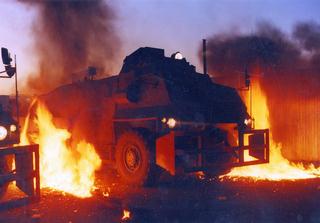




MOUT HOMEPAGE NOTE:
This section is part of the Tank Operations in Urban Terrain Program of Instruction. It is presented here as a separate POI because of space constraints and to facilitate ease of downloading in its Internet version.
INTRODUCTION
GAIN ATTENTION
PURPOSE
The purpose of this period of instruction is to familiarize the student with urban operations that may require the tank-infantry team to operate with many constraints placed on weapons employment due to the nature of the mission, the close proximity of non-combatants and the rules of engagement (ROE).
INDIVIDUAL TRAINING STANDARDS
MISSION PERFORMANCE STANDARDS
TERMINAL LEARNING OBJECTIVE
ENABLING LEARNING OBJECTIVES
METHOD AND MEDIA
TESTING
This period of instruction will be tested on your first deployment to an urban area where the Marine mission is of a peacekeeping, peacemaking or a humanitarian operations nature. These types of missions may be more difficult than any other you might encounter - this is because the enemy is not well defined and the possibility of accidental death or injury to noncombatants and collateral damage to the urban infrastructure is always present.
TRANSITION
BODY
1. Military Operations Other Than War (MOOTW)
a. The MOOTW Environment: These types of operations have - are - and - will be required of Marine and Naval Expeditionary forces across the globe - in any country - in any clime or place. To deal with the diverse situations Marine units may face during MOOTW in an urban environment, each and EVERY Marine must understand the cultural, political, and economic situation; as well as having a military appreciation of the terrain, weather; and the threat (conventional and unconventional). This understanding includes the general military situation; tactics, techniques and procedures (TTPs) used by the belligerent and the type of threat whether it be urban guerrilla, terrorist or criminal. Marine orientation training should clarify these "environmental considerations" - the operational tempo, local news media, international and U.S. news media, what the U.S. role is in this operation (mission - desired end state of the conflict), and the requirements for peacekeeping and/or peace enforcement operations. The overwhelming visual image of an M1A1 tank as well as its ability to intimidate may render the M1A1 either suitable or unsuitable for MOOTW.
b. Tempo: Although extreme tensions may exists between the urban belligerents, friendly forces and the MOOTW mission in general; the tempo of operations tends to be of a slow nature. For the tank platoon or section, the key to force protection is to maintain the highest level of operations security (OPSEC) and to vary the techniques by which these security procedures are executed.
c. ROE: These restrictions on the use of force during military operations are imposed based on the political and tactical situation within the urban area. Under these circumstances, the value of the M1A1 is that of a significant Marine presence and capability that can take small arms fire and other adversary/mob attack methods and at the same time show restraint. This, in and of itself, political consequences. The urban enemy will exploit ROE and the limitations they impose on Marine units. Small unit leaders must be prepared to repulse any attempt to take advantage of these restrictions. At the same time (and sometimes very difficult) they must not violate the ROE.
d. Force Protection: As with any operation, force protection is a primary goal for each and every unit leader while operating in a MOOTW environment. Force protection becomes especially difficult when performing MOOTW missions in an urban environment. That said, it is incumbent on every Marine tanker and tank commanders/leaders to ensure proper RTP, strict noise and light discipline as well as effective use of cover and concealment. Just as important is the use of obstacles, observation posts (OPs), and early warning devices, the protection afforded by armor vehicles, and safe locations for eating and sleeping.
e. Marine Responsibility: The professionalism and discipline instilled in a well-trained, well- informed and effectively led Marine are critical to the safe accomplishment of the MOOTW mission. Discipline is key when it comes to security. Leaders should stress that terrorists and thieves may attempt to infiltrate positions and mount tanks either to steal equipment and supplies or to cause harm to U.S. forces or facilities.
f. Media Concerns: Foremost, all tank units and units working with tank units during MOOTW, should be aware of the M1A1's high value to a potential foe as a target. This, coupled with the high visibility of the M1A1 and the resulting attention of the media, could lead to situations that would send the "enemy's message" back to the American public. Increasingly, U.S. forces are facing a new enemy, one who does not fight in a traditional structured manner. Instead, this new foe will attempt to take advantage of the American public's sensitivity to the loss of American service member's lives in order to meet his goals. What better message to send, than the destruction of an M1A1 (best main battle tank in the world) manned by U.S. Marines (considered a superior fighting force around the world).

g. Examples of MOOTW Missions:
1) Nonessential Evacuation Operation (NEO)
2) Security
3) Demining
4) Humanitarian
5) Convoy security
6) Escort missions
7) Mounted patrols
8) Checkpoint overwatch
9) Reaction force
10) Cordon and search
QUESTIONS
SUMMARY

The MOUT Homepage Hot Links:
U.S. Army FM 100-20 Military Operations in Low Intensity Conflict
U.S. Army FM 100-23 Peace Operations
U.S. Army FM 90-29 Noncombatant Evacuation Operations
Handbook for the Soldier in MOOTW (CALL)
Operations Other Than War: Mission Types and Dimensions
Joint Publication 3-07: Joint Doctrine for MOOTW
Peace Support Operations (UK draft Pub 3-01)
Stability and Support Operations (SASO) (CALL Newsletter)


| HOME | CONCEPTS | DOCTRINE |
| OPERATIONS 1 | OPERATIONS 2 | TECHNOLOGY |
| COMMERCIAL | RESEARCH | MOUT FORUM |
| COMMENTS | SIGN GUESTBOOK | VIEW GUESTBOOK |
| UNITS/IMAGES | DEDICATION |

